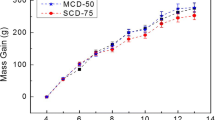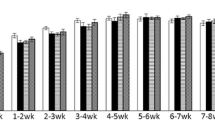Summary
It is generally agreed that combined deficiency of selenium and vitamin E leads to several abnormalities including Kashin-Beck disease which is an endemic and chronic degenerative osteoarthrosis. The abnormalities can be reversed by the administration of various forms of selenium and vitamin E.
The present study was designed to investigate the effects of dietary selenium and vitamin E on bone tissue and on the biomechanical properties of bone. Young rabbits of both sexes were fed with either a selenium- and vitamin E-adequate diet (control group), or a selenium- and vitamin E-deficient diet or a selenium-excess diet. The selenium-deficient diet resulted in a significant decrease in plasma selenium level and the selenium-excess diet resulted in a significant increase in the plasma selenium level with respect to the corresponding control values (p<0.05). The diets did not affect the blood cell counts considerably but erythrocyte glutathione peroxidase activity increased (decreased) relatively when the plasma selenium level increased (decreased) (p<0.05). The light microscopic investigations of the bone tissues of the two experimental groups indicate that the findings of the present work are compatible with osteomalacia. The biomechanical properties of the bones from the three groups were determined experimentally with bending tests. Both the Se-and vitamin E-deficient diet and the Se-excess diet decreased the biomechanical strength of the bones significantly while the bones belonging to the control group always had the largest modulus of elasticity (p<0.05).
Similar content being viewed by others
References
Schwarz K, Foltz CM. Selenium as an integral part of factor 3 against dietary limer generation. J American Chem Society 1957; 79: 3292–3.
Thomson JN, Scott ML. Impaired lipid and vitamin E absorption related to atrophy of the pancreas in selenium deficient chicks. J Nutrition 1970; 100: 797–809.
Thomson CD, Ong LK, Robinson MF. Effects of supplementation with high selenium wheat bread on selenium glutathione peroxidase and related enzymes in blood components of New Zealand residents. Am J Clin Nutr 1985; 41: 1015–22.
Rotruck JT, Pope AL, Ganther HE, Swanson AB, Hafeman DG, Hoeskstra WG. Selenium: Biochemical role as a component of glutathione peroxidane. Science 1973; 179: 558–90.
Flohe L, Gunzler WA, Schock HH. Glutathione peroxidase is a seleno enzyme. FEBS Lett 1973; 32: 132.
Schwartz K, Bieri JG, Riggs GM, Scott ML. Prevention of oxidative diathesis in chicks by factor 3 and selenium. Proc Soc Exp Biol Med 1957; 95: 621–5.
Muth OH, Oldfield JE, Remmert LF, Schubert JR. Effects of selenium and vitamin E on white muscle disease. Science 1958; 128: 1090.
Baker SS, Lerman R, Krey S, Crocker K, Hirsh E, Cohen H. Selenium deficiency with total parenteral nutrition: Reversal of biochemical and functional abnormalities by selenium supplementation. Am J Clin Nut 1983; 38: 769–74.
Sprinker L, Harr J, Newberne P, Whanger P, Weswig P. Selenium deficiency lesions in rats and vitamin E supplemented rations. Nutr Rep Int 1971; 4: 335–70.
Helzlsouer KJ. Selenium and cancer prevention. Semin Oncol 1983; 10:305–10.
Burk RF. Biological activity in selenium. Annu Rev Nutr 1983; 3: 53–70.
Chen X, Yang G, Chen J, Wen Z, Ge K. Studies on the relations of selenium and Keshan disease. Biol Trace Elem Res 1980;2:91–107.
Sokoloff L. Endemic forms of osteoarthritis. Clin Rheum Dis 1985; 11:187–212.
Neve J. Physiological and nutritional importance of selenium. Experientia 1991;47: 187–92.
Baptista RJ, Bistrian BR, Blackburn G, Miller D., Champagne CD, Buchanan L. Utilizing selenous acid to reserve selenium deficiency in total parental nutrition patients. Am J Clin. Nutr 1984;39: 816–20.
Neve J, Vertongen F, Thonnart N, Carpenter YA. Assessment of selenium status in patients receiving long-term total parental nutrition. In: Bratter, P., Schramel, P., W. de Gruyter, editors. Trace Element Analytical Chemistry in Medicine and Biology. Berlin, New York, 1984:139–149.
Dimitrov NV, Ullrey DE. Considerations concerning a phase I clinical trial of selenium compounds. J Am Coll Toxicol 1986; 5: 95–100.
Caravaggi C, Clark FL, Jackson ARB. Acute selenium toxicity in lambs following intramuscular injection of sodium selenite. Res Veter Science 1970; 11: 146–9.
Caravaggi C, Clark, FL, Jackson ARB. Experimental acute toxicity of orally administered sodium selenite in lambs. Res Veter Science 1970; 11: 501–2.
Hopper SA, Greig A, McMurray CH. Selenium poisoning in lambs. Veterinary Record 1985; 116: 569–71.
Harr JR. Selenium poisoning in domestic animals and its relationship to man. Clin Toxicol 1972; 5: 175–81.
Venugopal B, Luckey T. Metal toxicity in mammals. In:Toxicity of Group VI Metals and Metalloids, Plenum Press, New York, 1978: 234–54.
Symth JBA, Wang JH, Barlow RM, Humphreys DJ, Robins M, Stodulski JBJ. Experimental acute selenium intoxication in lambs. J Comp Path 1990; 102: 197–209.
Combs GF Jr, Levander OA, Spallholz JE, Oldfield JE (Eds).Selenium in Biology and Medicine, New York. AVI, von Nostrand, New York, 1987.
Lin-Shiau SY, Liu SH, Fu WM. Studies on the contracture of the mouse diaphragm induced by sodium selenite, Eur J Pharmacol 1989; 167: 137–46.
Spallholz JE. On the nature of selenium toxicity and carcinostatic activity. Free Radical Biol Med 1994;17 (1): 45–64.
Yang C, Niu C, Bodo M, Gabriel E, Notbohm H, Wolf E, Muller PK. Fulvic acid supplementation and selenium deficiency disturb the structural integrity of mouse skeletal tissue. J Biochem 1993; 289: 829–35.
Sasaki S, Iwata H, Ishiguro N, Habuchi O, Miura T. Low-selenium diet, bone and articular cartilage in rats. Nutrition 1994; 10 (6): 538–43.
Yang C, Wolf E, Roser K, Delling G, Muller PK. Selenium deficiency and fulvic acid supplementation induces fibrosis of cartilage and disturbs subchondral ossification in knee joints of mice: an animal model study of Kashin-Beck disease. Virchows Arch. A. Pathol Anat Histopathol 1993; 423 (6): 483–91.
Ringstad J, Tande PM, Norheim G, Refsum H. Selenium deficiency and cardiac electrophysiological and mechanical function in the rat. Pharmacol Toxicol 1988; 63: 189–92.
Koukay N, Mouhieddine S, Richard MJ, Arnaud J, De Leiris J, Favier A. Influence of selenium on lipid peroxidation and cardiac functions in chronically adriamycin-treated rats. In: Emrit, I. et al., editors.Antioxidants in Therapy and Preventive Medicine. Plenum Press, New York, 1990.
Eskew ML, Scholz RW, Reddy CC, Todhunter DA, Zarkower A. Effects of vitamin E and selenium deficiencies on rat immune function. Immunology 1985; 54: 173–80.
Yamada H. Strength of Biological Materials. Evans, F.G., Williams & Wilkins Co., editors. Baltimore, 1970.
Turner CH, Burr DB. Basic biomechanical measurements of bone: A tutorial. Bone 1993; 14: 595–608.
Turan B, Delilbasi E, Dalay N, Afrasyap L, Sengun Z. Therapeutic selenium supplementation: Activities of glutathione peroxidase and superoxide dismutase in several rabbit tissues. Romanian J Biophys 1992; 2 (2): 121–7.
Turan B, Dalay N, Afrasyap L, Delilbasi E, Sengun., Sayal A, Isimer A. The effects of selenium supplementation on antioxidative enzyme activities and plasma and erythrocyte selenium levels. Acta Physiol. Hungarica 1993; 81 (1): 87–93.
Dalay N, Turan B, Koc E, Afrasyap L, Delilbasi E. The effects of in vivo selenium supplementation on the amplitude of the spontaneous contractions and the responses to acetylcholine in isolated rabbit ileum. Neurobiology 1993; 1 (1): 83–90.
Turan B, Zaloglu N, Koc E, Saran Y, Akkas N. Dietary selenium and vitamin E induced alterations in some rabbit tissues. Biol Trace Elem Res 1997; 58 (1–2): in press.
Turan B, Koc E, Zaloglu N. Deficiency and toxicity of selenium alter the acetylcholine stimulated contraction of isolated rabbit ileum. Trace Elem. Electrolytes 1997; 58 (1–2): in press.
Grupp IL, Jamall S, Millard RW, Grupp G. Effects of dietary selenium deficiency and selenium and cadmium supplementation on myocardial contractile force and ouabain sensitivity on the rat heart. IRCS Med Sci 1983; 11: 22–3.
Baenker RL, Boxer LA, Aller JM. Autoxidation as a basis for altered function by polymorphonuclear leucocytes. Blood 1977; 50: 327–32.
Hoekstra WG. Biochemical function of selenium and its relation to vitamin E. Fed Prod Fed Am Soc Exp Biol 1975; 34: 2083–9.
Salbe AD, Levander OA. Comparative toxicity and tissue retention of selenium in methionine-deficient rats fed sodium selenate or L-selenomethionine. J Nutr 1990; 120: 207–12.
McAdam PA, Levander OA. Chronic toxicity and retention of dietary selenium fed to rats as D- or L-selenomethionine, selenite or selenate. Nutr Res 1987; 7: 601–10.
Mo DX. Pathology and selenium deficiency in Kashin-Beck disease. In: Combs, G.F. Jr., AVI, von Nostrand, et al., editors. Selenium in Biology and Medicine., New York, 1987: 924–33.
Krishnamurthy S. The intriguing biological role of vitamin E. J Chem Ed 1983; 60: 465–70.
Sokol RJ. Vitamin E deficiency and neurologic disease. Ann Rev Nutr 1988; 8: 351–5.
Author information
Authors and Affiliations
Rights and permissions
About this article
Cite this article
Turan, B., Balcik, C. & Akkas, N. Effect of dietary selenium and vitamin E on the biomechanical properties of rabbit bones. Clin Rheumatol 16, 441–449 (1997). https://doi.org/10.1007/BF02238935
Received:
Accepted:
Issue Date:
DOI: https://doi.org/10.1007/BF02238935




